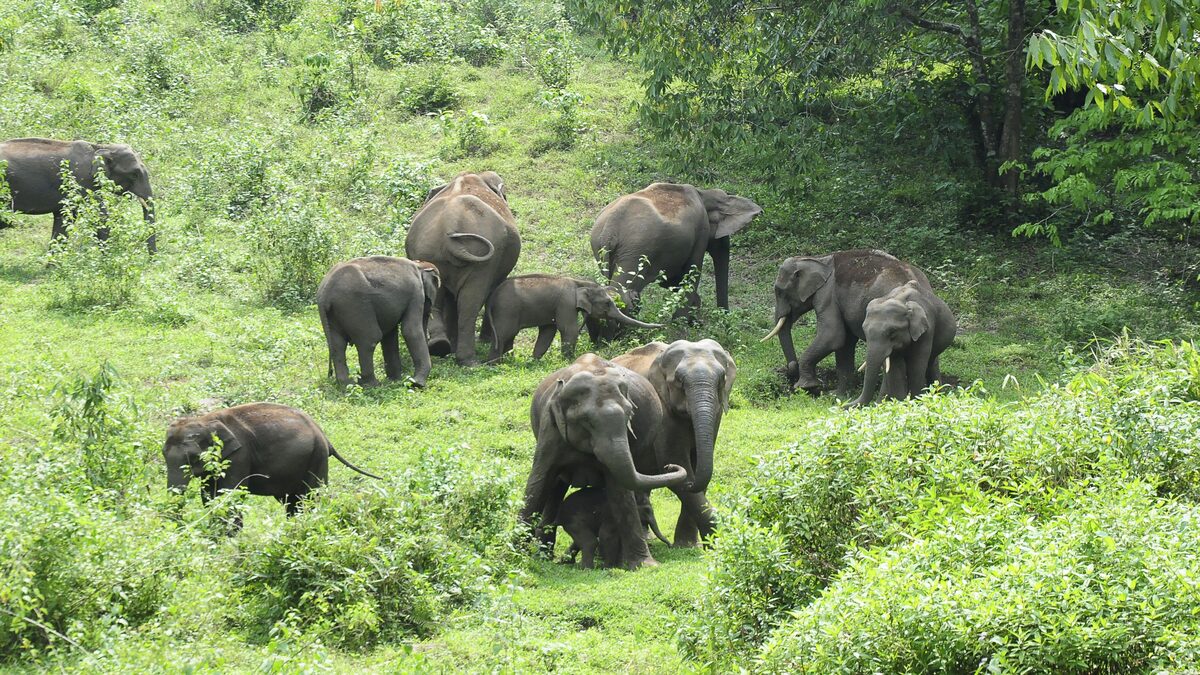A man was killed by a stray wild elephant on Monday night (26 February) in the Kannimala estate near the tourist town of Munnar in Kerala’s Idukki district. This is the third such death due to elephant attacks in the southern state this month.
The tragedy has once again shed the spotlight on the rising human-animal conflict in Kerala. Let’s look at these recent incidents, what the data shows about the human-animal conflict in the state and why this is happening.
Another death in elephant attack in Kerala
Suresh Kumar, alias Mani, was attacked by a wild elephant last night while driving passengers in his auto. According to the police, the tusker also toppled his autorickshaw but the passengers had a narrow escape, PTI reported.
The incident occurred when 44-year-old Kumar was on his way to drop a couple and their daughter home after the annual day celebration at the girl’s school. Two migrant workers were also in the auto at the time of the attack, as per the news agency.
Rajeena, who was travelling in the auto with her daughter and husband, told reporters that they were trapped beneath the vehicle after the elephant attack. She said the animal attacked Kumar when he tried to leave from the auto.
“The elephant took him by the trunk and tossed him three times. We were rescued by some persons who were passing by in a jeep. They helped us come out of the toppled vehicle after the elephant moved away,” she was quoted as saying by PTI.
Impact Shorts
More ShortsAccording to a senior police officer, the auto driver, who was critically wounded in the attack, died before reaching a hospital.
The incident comes in the wake of two men killed in separate attacks by elephants in Wayanad recently.
On 10 February, a wild elephant named Belur Makhna trampled a man to death in Wayanad’s Mananthavady municipality. The death of Ajeesh Joseph, a 42-year-old farmer, by the radio-collared tusker had triggered strong protests by the locals.
Six days later, Pakkam Vellachalil Paul, a 50-year-old watcher with the Kuruva Island ecotourism centre, was killed in an elephant attack in Pulpally town, also leading to protests. These tragic incidents had prompted Congress MP Rahul Gandhi to visit his parliamentary constituency, Wayanad, to meet the families of the animal attack victims.
Shri @RahulGandhi met with the families of Late Shri Ajeesh and Late Shri Paul VP, who tragically lost their lives in fatal elephant attacks in Wayanad.
— Congress (@INCIndia) February 18, 2024
He assured them of full support during this difficult time. pic.twitter.com/BfEZkPv7dt
Kerala’s human-animal conflict
The human-animal conflict is a big problem in Kerala. Almost 30 percent of the state is covered in forests, consisting of 16 wildlife sanctuaries, six national parks, and two tiger reserves, ThePrint reported. Kerala accounts for 2.3 per cent of India’s forest cover.
The forest department states that most of the human-wildlife conflicts occur in the fringes of these forests. According to Indian Express, Kerala has witnessed a rise in attacks by wild animals such as elephants, tigers, bison, and wild boars, with the districts of Wayanad, Kannur, Palakkad and Idukki being the worst affected.
The hill district of Wayanad, which reported at least 41 casualties due to elephant attacks and seven from tiger attacks over the last decade, has a forest cover of 36.48 per cent in Kerala, the newspaper reported.
Its forests are part of a greater forested area including Nagarhole Tiger Reserve, Bandipur National Park, and BR Tiger Reserve in Karnataka, and Mudumalai Tiger Reserve and Sathyamangalam Forest in Tamil Nadu, noted Indian Express.
Currently, Kerala has an estimated population of 2,386 elephants.
Seventeen people died in elephant attacks in the state in 2023-24, PTI reported citing the forest department data. This is a fall from 27 fatalities recorded in 2022-2023 and 35 in 2021-2022.
As per the government data for 2022-23, of the 8,873 wild animal attacks, 4,193 were by elephants, 1,524 by wild boars, 193 by tigers, 244 by leopards, and 32 by bison.
Besides harming humans, the wild animal attacks have also impacted the southern state’s agriculture sector. As many as 20,957 incidents of crop loss and the killing of 1,559 domestic animals, mainly cattle, were reported from 2017 to 2023 in Kerala due to such attacks, as per Indian Express.
According to a Rajya Sabha reply, there were about 4,500 instances of cattle, crop, or property loss due to animal attacks last year in the state, ThePrint reported.
Why is this happening?
Environmental activists say deforestation is the main catalyst driving elephants away from their natural habitats and into human settlements for food and water.
A 2020 study published in the Current Science journal blames the surge in ‘degradation’ of Wayanad’s forest among other reasons for the escalating human-elephant conflict in the region. The paper also warned against the conversion of forests into agricultural landscapes and the loss of biodiversity spots like swamps and bamboo clumps in the hill district, ThePrint reported.
A 2018 study by Dehradun’s Wildlife Institute of India and the Periyar Tiger Conservation Foundation in Kerala found that changes in agri-practices and declining quality of forest habitats were behind the increasing human-animal conflict in the state.
As 30,000 hectares of forest land in Kerala is being utilised for the cultivation of alien plants — mostly acacia, mangium and eucalyptus, animals are losing their natural habitat and food sources, according to Indian Express.
“Today, around 36,000 of 96,000 hectares of Wayanad forests are monoculture plantations such as eucalyptus,” N Badusha, a 71-year-old farmer and environmental activist, told BBC.
“The pristine and precious green spaces, vast swamps and wetlands are depleting,” he said, adding that this is pushing wild animals onto farmlands and residential areas.
Locals also blame growing tourism industry, cattle grazing, invasive plants and forest fires for damaging wildlife habitats in the region.
Speaking to ThePrint, Nishant Srinivasiah, a behavioural ecologist who specialises in Asian elephants’ behaviour in human-dominated landscapes in the Eastern Ghats, said that until development goals remain human-centric, conflicts with elephants will continue. “We need to take into account non-humans such as elephants and other animals and their ecological, biological, and social needs when we alter landscapes for our own use and advantage”.
What is Kerala doing?
Amid an uptick in incidents of wild elephants, authorities in the Idukki district have decided to deploy a Rapid Response Team (RRT).
Earlier this month, in a meeting convened by Kerala chief minister Pinarayi Vijayan, it was decided to install 250 “advanced cameras” along forest borders and wildlife corridors to keep track of the movement of animals.
“The chief minister has also ordered round-the-clock patrolling of state forests,” Vijayan’s office said in a statement.
Kerala also has schemes such as the construction of elephant-proof trenches, elephant-proof stone walls, and solar-powered electric fencing to prevent animals from entering human settlements.
The government is also working on eco-restoration programmes to keep animals in forests.
As Kerala forest minister AK Saseendran told the BBC, “We need to protect the lives of both humans and animals and ensure a healthy coexistence”.
With inputs from agencies


)

)
)
)
)
)
)
)
)



